

Sweet Tooth: Wagashi for Every Occasion
|
From cakes to parfaits and pudding, Western confectionaries enjoy immense popularity in Japan as souvenirs or as delicious mid-day treat at a café. But Japan also has a history of traditional cakes and sweets, the legacy and popularity of which endures even till today. These traditional sweets, known as wagashi, come in various designs and colours, making them not only a treat for the stomach but also for the eyes.
There is no standard definition of wagashi, and there is a truly diverse selection of traditional sweets that can be classified as such. However, they can be further classified into broad categories based on their base ingredient or by the methods they are made. These categories include mochimono, which comprises confections made with rice mochi, such as kashiwamochi, daifuku, and ohagi; mushimono, confections that are made by the process of steaming; yakimono, confections that are made by baking, either in copper plates or in ovens, like dorayaki and kurimanju; nagashimono, confections that are made by pouring ingredients into a mold, such as yokan; nerimono, confections that are made by shaping bean paste; okamono, which refers to confections made by combining separate ingredients, like monaka; and finally, uchimono, which refers to confections that are placed in molds and hardened through beating, such as rakugan. |
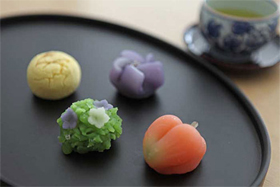 © Web Japan 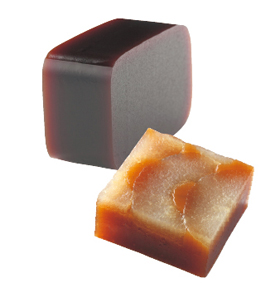 © Natori Kazuhisa (Collaboration: TORAYA Confectionery Co., Ltd.) |
|
Wagashi are very closely associated with tea ceremonies. If you have attended one of the many tea ceremony demonstrations that have been held at JCC, you may be familiar with the pretty and delicately-crafted sweets that are served as accompaniments to the tea. Traditional Japanese sweets and cakes were developed alongside the tea ceremony; the way of tea was formalised in the sixteenth century, and likewise, many of the wagashi that we are familiar with today were also first made around then, during the Edo period (1603-1868). The type of wagashi that is usually served during tea ceremonies are nerimono (confections made by shaping bean paste) or uchimono (confections placed in molds and hardened through beating). These types of sweets are usually made in the shape of various flowers and symbols to reflect the feeling of a particular season.
It is not only the wagashi that is served in tea ceremonies that reflect the seasons. Other wagashi have seasonal characteristics as well! In spring, sweets come in colours like pink and green, symbolising freshness and abundance. Design-wise, many sweets can come in the shapes of springtime plants like pine trees, apricots, and cherry blossoms. Sweets in autumn are coloured in earthy tones like orange, and use seasonal flavours like chestnuts and persimmons. Yokan jellies are common in summer, as a cool treat in hot weather, and in winter, many sweets are coloured white to bring the image of falling snow to mind. There are also wagashi that are served as part of events and festivals as well. For example, in our previous article about the Girls’ Festival (Hina Matsuri), we introduced the hishimochi, which are traditional sweets that are presented to the dolls on display. These sweets are dyed pink, white, and green to represent fertility. For Children's Day in May, kashiwamochi, rice cakes stuffed with sweet red bean paste and wrapped with oak leaves, are eaten. Hanabira-mochi are commonly served the first tea ceremony held in the beginning of a new year. These sweets are made to look like plum blossom petals, and are made with newly harvested burdock that is boiled and sweetened and wrapped with white bean paste mixed with miso. As the selection of wagashi available in shops changes, customers are able to appreciate the seasonal changes as well. With the sheer variations of wagashi available, alongside the many possible designs and colours, you are sure to find a treat that you can enjoy on its own or with a nice cup of green tea. |
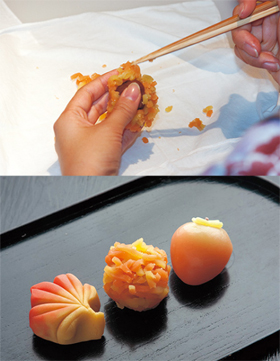 © Takahashi Hitomi (Collaboration: Kanshundo) 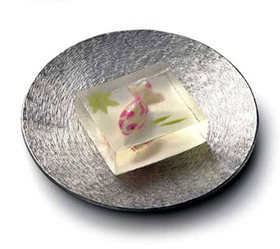 © Toraya Corp 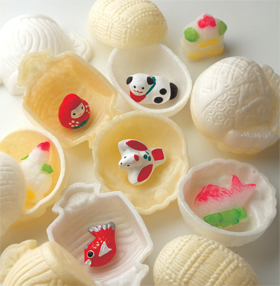 © Moroe-ya Confectionery |
Resources
|
Association, T. W. A. (n.d.). About Wagashi. Retrieved from https://www.wagashi.or.jp/japanesesweets-wagashi/en/about/ |
|
Japan Creative Centre 4 Nassim Road, Singapore 258372 +65 6737 0434 / jcc@sn.mofa.go.jp https://www.sg.emb-japan.go.jp/JCC/ Nearest parking at Orchard Hotel & Delphi Orchard |
 |